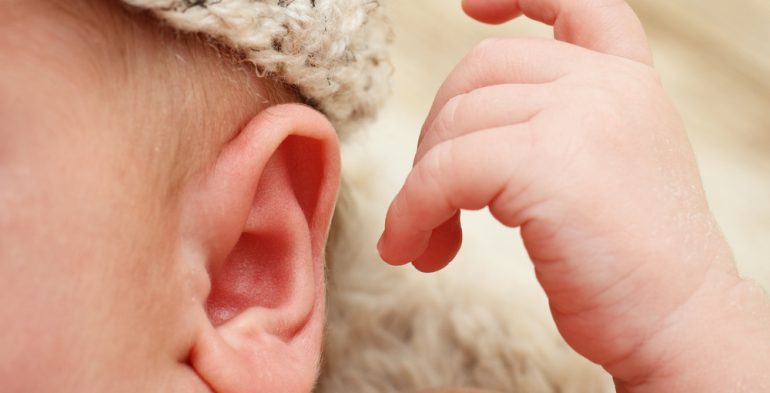
|
Yes |
No |
Hearing and Comprehension |
Child’s Age |
Speech |
Yes |
No |
|
|
|
Does your baby listen when spoken to? Does he startle to sudden sounds? Does he wake up to noise? |
At Birth |
Does your baby make pleasure sounds? When you play with him, does he look at you then away then back at you again? |
|
|
|
|
|
Does he look at you when you talk? Does he smile when spoken to? Does he recognize your voice and calms down when he hears it when crying? |
0-3 months |
Does he repeat sounds often (cooing)? Does he cry differently for different needs? Does he smile when he sees you |
|
|
|
|
|
Does he respond to saying “no” or changes in tone of your voice? Does he look for the source of new sounds such as phone ringing or vacuum cleaner or dog barking? Does he notice toys that make sounds? |
4-6 months |
Does his babbling sound more speech-like with many different sounds, including p, b and m Does he ask you to repeat sounds whether by gestures or sounds? Does he make cooing sounds when left alone and when playing with you? |
|
|
|
|
|
Does he recognize words for common items like “plate”, “milk”, “bag”? Did he begin to respond to requests (e.g. “Come here” or “Want more?”)? Does he enjoy games like peek-a-boo*? Does he turn and look in direction of sounds when his name is called? |
7 months-1 year |
Does he have one or two words (mama-baba-byebye), although sounds may not be clear? Does his babbling have both long and short groups of sounds such as “tata upup bibibibi”? Does he imitate different speech sounds? Does he use speech or non-crying sounds to get your attention? |
|
|
|
|
|
Can he point to pictures in a book when named? Can he point to a few body parts when asked? Does he follow simple commands and understand simple questions (“Kiss the baby,” “Throw the ball,” “Where’s your shoe?”). Does he listen to simple stories and songs? |
1-2 years |
Does he say more words every month? Does he use some one- or two- word questions (“Where mama?” “Go bye-bye?” “What’s that?”)? Can he put two words together (“mommy close,” “no milk,” “more chocolate,” “mommy toy”)? Does he use many different consonant sounds at the beginning of words? |
|
|
|
|
|
Does he understand differences in meaning (“big-little,” “up-down” “in-on,”)? Does he still notice sounds of the doorbell, telephone ringing and television? Can he follow two requests (“Get the ball and put it on the table”)? Can he answer simple “who?”, “what?”, and “where?” questions? |
2-3 years |
Does he have a word for almost everything? Does he use two- or three- words to talk about and ask for things? Is his speech understood by you most of the time? Does he often ask for or direct attention to objects by naming them? Does he talk about activities at school or at friends’ homes? Does he pronounce almost all sounds correctly except a few like R, S, L, T? Does he usually talk easily without repeating syllables or words? Do people outside of the family usually understand the child speech? Does he use a lot of sentences that have 4 or more words? |
|
|
|
|
|
Does he hear and understand most of what is said at home and at school? Do all people that know him think he hears well (his teacher, nanny, grandparents, etc.)? Does he pay attention and respond to some simple questions when told a story? |
4-4.5 years |
Does he sound as clear as other children? Does he use detailed sentences such as “I have three big red balls at home”? Can he tell a short story without straying? Can he speak easily with other children and adults? Does he pronounce almost all sounds correctly, except one or two? Does he use grammar and syntactic structures used by his family? |
|
|
|
|
|
Total |
|
Total |
|
|
* peek-a-boo: a person hides his eyes with his hands then takes them away and says “peek-a-boo”
Instructions
Read every question in the age group of your child carefully then respond with “yes” or “no” based on your child’s condition. Calculate the total then check the following scoring scheme:
** If all answers are “yes” then your child’s language, speech and hearing are developing naturally.
** 1 – 2 “No’s”, be careful, your child’s language, speech and hearing might be underdeveloped, read the notes in the “Remember” section of this guide.
** 3 or more “No’s”: take your child to a specialist immediately (See “Where can I find help”)
Remember
Do the following for a better pronunciation, language, and hearing:
- Speak naturally to your child, describe what you do or see or what he does or sees.
- Dedicate some time to talk to your child and listen to him, and respond to the context so he knows you are listening carefully.
- Do not force your child to speak and accept many of the mistakes he makes when speaking while he grows. Do not ask him to slow down or repeat words.
- Take your child to a hearing therapist to measure his hearing if you find that you have to repeat things a lot or need to speak louder to draw his attention.
- Do not hesitate to consult specialists if you are not sure. Rush to see a doctor if you believe something is wrong, you know your child better.
Where can I find help?
If you suspect that your child has a language, speech or hearing problem, you can call one of the following:
- A speech and language pathologist – A hearing therapist
- School language, speech and hearing programs
- Language, speech and hearing centers
- Hospital language, speech and hearing clinics
- University language, speech and hearing clinics
- The family’s doctor.
0 – 1 Year:
- Check your child’s ability to hear, and pay attention to ear problems and infections, especially when they keep occurring.
- Reinforce your baby’s communication attempts by looking at him or her, speaking, and imitating his or her vocalizations.
- Imitate his or her laughter and facial expressions.
- Teach your baby to imitate actions, such as peekaboo, clapping, blowing kisses. These games teach turn taking that is needed for conversation.
- Talk while you are doing daily activities, such as helping your child dress or undress, bathe, and eat (e.g.,”Sam is eating carrots”; “Oh, these carrots are good!”; “Sam is wearing a red shirt”).
- Talk about where you are going, what you will do once you get there, and who and what you will see (e.g., “Sam is going to Grandma’s house. He will meet his cousins there and will play with them.”).
- Talk about colors (e.g., “Sam’s shirt is red.”)
- Practice counting. For example, count toes and fingers. Count steps as you go down or up the stairs.
- Teach your child animal sounds (e.g., “A cow says ‘moo'”).
1-2 Years:
- Talk while taking a walk or going out on a picnic. When walking, for example, point to familiar objects (e.g., cars, trees, cats and birds) and say their names. “I see a cat. The cat says ‘meow.’ This is a big cat. This cat is white.”
- Use simple but grammatical speech that is easy for your child to imitate.
- Take a walk around your house or in the baby’s room. Introduce him/her to the clock, which makes the sound “tick-tock-tick-tock.” Play with an airplane, moving it up and down and making its “voooo” sound. These sounds will stick in your child’s memory until he is introduced to phonics in kindergarten and school.
- Make bath time playtime as well. You are eye-level with your child. Play with him and make different sounds. For example, blow bubbles and make the sound “b-b-b-b.” Move his engine boat in the water and make a wonderful “rrr-rrr-rrr” sound.
- Expand on his words. For example, if your child says “car,” you respond by saying, “You’re right! That is a big red car.”
- Continue to find time to read to your child every day. Try to find books with large pictures and one or two words or a simple phrase or sentence on each page. When reading to your child, take time to name and describe the pictures on each page. Have your child point to pictures that you name. Encourage your child to name pictures by pointing to them as you read. He or she may not respond to your naming requests at first. Just ask then name the pictures for him or her. One day, he or she will surprise you by coming out with the picture’s name.
2-3 Years:
- Show your child that you are interested in what he or she says to you by repeating what he or she has said and expanding on it. For example, if your child says, “pretty flower,” you can respond by saying, “Yes, that is a pretty The flower is bright red. It smells good too. Do you want to smell the flower?”
- Let your child know that what she or he has to say is important to you by asking him or her to repeat things that you do not completely understand. For example, “I know you want a block. Tell me again which block you want.”
- When reading for your child, state synonyms for familiar words (e.g., mommy, woman, lady, grown-up, adult) and use this new vocabulary in sentences to help your child learn it in context.
- Put objects into a pocket or box and have your child remove one object at a time, saying its name. Repeat what your child says and expand upon it, for example, if he says “comb” you can say: “That is a comb. Sam combs his hair.” You can also group the objects in the box into categories (e.g., clothes, food, drawing tools…).
- Cut out pictures from old magazines and make a scrapbook of familiar things. Give your child the chance to help you with this, make him glue the pictures into the scrapbook. Practice naming the pictures, using gestures and speech to show how you use the items in the pictures.
- These pictures can be used to make silly pictures. For example, glue a picture of a dog to the inside of a car as if the dog is driving. Help your child explain what is silly about the picture.
- Look at family photos and name the people. Use simple phrases/sentences to describe what is happening in the pictures. Write simple appropriate phrases under the pictures then read them while you are looking at them. Your child will begin to understand that reading is oral language in print that expresses all sorts of things.
- Ask your child questions that require a choice, rather than simply a “yes” or “no” answer. For example, rather than asking, “Do you want milk?”, ask, “Would you like a glass of milk or juice?” Be sure to wait for the answer, and reinforce successful communication: “Thank you for telling mommy what you want. Mommy will get you a glass of milk.”
- Continue to sing songs, play finger games (“Where is Thumbkin?”). These games introduce your child to the sounds of letters in language and rhythm in speech.
- Enhance your child’s language comprehension skills by playing the yes-no game: “Are you a boy?” “Is that a horse?” “Is your name Sam?”
3-4 Years:
- Sort items into categories, but increase the challenge by asking your child to point out the item that does not belong in a category. For example, a doll does not belong with a dog, cat and mouse. Tell your child that you agree with his or her answer because a toy is not an animal.
- Read books that have a simple plot. Ask your child to retell the story. Tell him or her your favorite part of the story and ask for his or her favorite part.
- Play the questions game. Have him ask you questions and pretend that some of them really hard questions that need his explanation.
- Expand social and communication skills by “acting out” typical scenarios (e.g., cooking food, going to sleep, or going to the doctor). As always, ask your child to repeat what he or she has said if you do not understand it completely. This shows that what he or she says is important to you.
- Talk about sequential relationships (first, middle, and last) and opposites (up and down, big and little).
- Describe some objects and ask your child to recognize and categorize it. You can ask him or her to add to characteristics you mentioned (shapes, colors, kinds).
- Follow your child’s directions as she or he explains how to do something.
- Give full attention to your child when he or she is speaking. Before you speak to your child, be sure to get his or her undivided attention. Pause after speaking, allowing him or her to respond to what you have said.
- Build on your child’ s vocabulary. Provide definitions for new words, and use them in context: “This vehicle is on the highway. It is a car. A bus is another kind of vehicle. So are a train and an airplane.”
- Encourage your child to ask for an explanation if he or she does not understand what a word means.
- Point out things that are the same or different. Play games, incorporating these concepts that he or she will encounter later in the classroom, when he or she learns to read.
- Sort items into categories. Now try to make it more challenging (e.g., rocks that are heavy vs. those that are light, big vs. small). Again, have your child identify the object that does not belong in a given category, but now ask him or her to explain why the item does not belong.
- Expand social communication skills by storytelling and role-playing, such as playing a doctor and treating you, using the appropriate dialogue for his or her role.
4-5 Years:
- Read stories with clear and easy-to-follow pictures. Help your child predict what will happen next in the story. Act out the stories, and put on puppet shows of the stories. Have your child draw a picture of a scene from the story, or of a favorite part. You can do the same with videos and TV shows. Ask “wh” questions (who, what, when, where, or why) and monitor his or her response.
- Expand your child comprehension (what he/she understands) and expressive (what he/she says) language skills by playing “I Spy”; where you ask what something is by mentioning its characteristics, for example: “I spy something round on the wall that you use to tell the time.” Take turns with your child, have him or her give you clues about something that he or she sees and figure out what it is.
- Give your child two-step directions (e.g., “Get your coat from the closet and put it on”). Encourage your child to give directions to explain how he or she has done something. For example, ask your child to explain how he made a structure out of Lego blocks. When playing doctor, ask your child to explain what he/she did to give the baby a checkup. Draw a picture, and write down your child’s story as he or she tells it. Your child will soon grasp the power of storytelling and written language.
- Play age-appropriate board games with your child (e.g., “Monopoly” or “Chutes and Ladders”).
- Have your child help you plan daily activities. For example, have him or her help you make a shopping list for the grocery store, or plan his or her party. Ask his or her opinion: “What kind of fruit do you want to buy at the store? What do you think your cousin would like for his party?”













